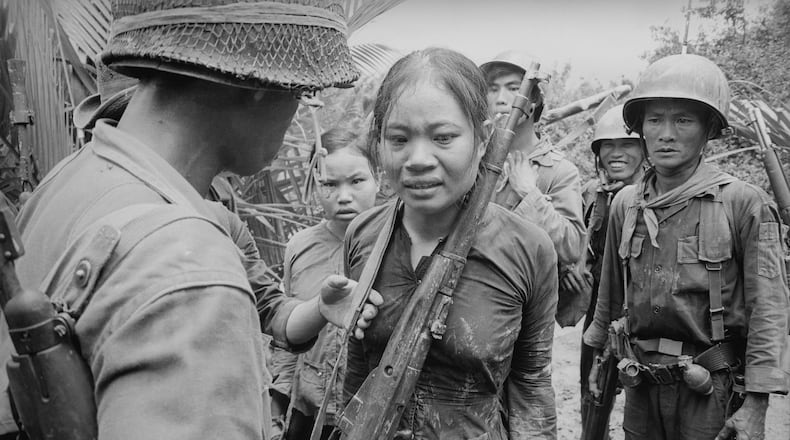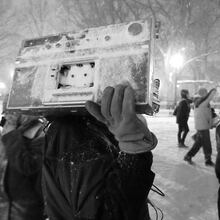The Vietnam War was a long, costly and bitterly debated conflict that pitted the Communist government of North Vietnam against anti-Communist South Vietnam and its principal ally, the United States.
Based on widely varying estimates, the war killed between 1.5 million and 3.6 million people.
Now, more than four decades later, "The Vietnam War," a 10-part, 18-hour documentary film series directed by Ken Burns and Lynn Novick, will tell the story of that war as it has never before been told on film.
The immersive narrative features testimony from nearly 100 witnesses, including many Americans who fought in the war and others who opposed it, as well as Vietnamese combatants and civilians from both the winning and losing sides. The series will premiere Sunday on PBS stations nationwide.
The first five episodes will air nightly from Sunday through Thursday, Sept. 21, and the final five episodes will air nightly from Sunday, Sept. 24, through Thursday, Sept. 28. Each episode will premiere at 8 p.m. EDT with a repeat broadcast immediately following the premiere.
“The Vietnam War was a decade of agony that took the lives of more than 58,000 Americans,” Burns said in a press release. “Not since the Civil War have we as a country been so torn apart. There wasn’t an American alive then who wasn’t affected in some way … and we are still arguing about why it went wrong, who was to blame and whether it was all worth it.”
One of the local veterans featured in the documentary is Jim Gillam, who served in Vietnam for 10½ months. In 1968, Gillam was a college student at Ohio University, poorly focused and failing. He was dismissed and then drafted into the Army. He became a sergeant and an instructor at the Fort McClellan Alabama School of Infantry. Several years after the war, Gillam became a professor at Spelman College in 1985, teaching classes on the history of China, Vietnam and Japan.
Gillam, 70, who is also an author and lives in Stone Mountain, is now a professor emeritus.
The AJC recently interviewed Gillam by phone. The interview has been edited for clarity and length.
Q: What are your first memories of arriving in Vietnam?
A: I was scared. It was late summer and it was very, very hot and humid. I got to the main base camp and the next day they shipped me to a small fire base (imagine a hilltop where they chop down and scrape away all of the vegetation, and they dig fox holes around the outside of the hill so you can look down in the valley) that had been attacked the night before. They put barbed wire around the fire base. They dropped me there with supplies, ammunition. My first job was taking dead bodies out of the barbed wire — these dead bodies were people attacking the fire base (who) got shot in the middle of the night — and bury them. … I stayed at that fire base for about a month and we patrolled looking for the enemy.
I was really pretty nervous when we landed at Cam Ranh Bay and I went through my first combat unarmed and hiding under my bed. I didn’t even have a gun. And then in a few days, I ended up in the mountains with my infantry unit, and I finally got a gun. The next scary thing that happened they said OK sergeant, take your squad and do a security control, get down in the valley and get around our fire base and make sure there are no enemies around there, and if there are, you are supposed to shoot them. I wasn’t really sure I was ready to lead soldiers in combat. I spent half of the time wondering how bad it hurt if you got shot.
Q: How did Vietnam change you?
A: While I was there, one thing I lost was my civility. The civilized version of Jim Gillam disappeared. I understood very clearly I was supposed to hunt people every day. And another thing that changed was my concept of what was long term, and what was near future. The long term for me was 10, 12 hours away. I sat in a hammock one time reading mail with two friends, and the guy leaning on me on my left got shot dead. He got shot four times in the chest and I didn’t get shot. So long term was what are we going to have for dinner and it is 3 p.m. in the afternoon. I became basically a callous, uncivilized person.
Q: Did the more sensitive, civilized Jim Gillam come back?
A: Some of my civilization came back. My first significant employment after the Army was running a veterans rehab program, and I think that was very cathartic for me. It did help me re-adjust, help me get back and move back into the direction of civilization.
Q: Did you suffer PTSD?
A: Yes, I did, but I was in denial about it. I refused to admit it. I saw it as a weakness. And as a soldier, particularly as an infantry small unit leader, I was not supposed to be weak. They didn’t call it PTSD back then. They called it shell shock or something like that.
Q: In the documentary, music plays heavily with Bob Dylan and the Beatles as songs of the era. Did you listen to these musical artists while in Vietnam?
A: Heck no. I am an African-American man, and brothers listened to, for the most part … music from Motown. I am 70 years old and I still can’t figure out what the big deal was about Bob Dylan or the Beatles.
Q: As a newly returning veteran from Vietnam, were you treated poorly?
A: Yes, I was. On the plane back from the West Coast, a woman sitting in my row was complaining about sitting next to me and a Marine. I wasn’t sure if it was because I was in uniform or because I am African-American. …When I got to Chicago O’Hare airport, a man walked up to me and punched me in the face. And when I got back to college, many of my friends would not talk to me, and some people thought it was funny to drop firecrackers around me and watch my reaction.
Q: The documentary also delves into racism during the war. Is that something you experienced?
A: There were things that would happen that would let you know you were different, and you were always different. One time on a fire base some idiot put up a Confederate flag on the fire base. I got a machine gun and shot the flag pole down. I wanted them to understand that this was an American fire base, it was not a Confederate fire base. There were a lot of hard feelings about stuff like that.
I had very good friends who were white guys, and I had people I absolutely despised and didn’t like who were black people. My standard at the time was, who is the most loyal and effective person in combat.
Q: What are your biggest takeaways from being in Vietnam?
It depends on the time. In June of 1970, what I took away from the war was me. I was happy to be back. What I take from it from 50 years later, is a historical perspective. I am able to see that I was part of very large important event.
I look at it now and see how people have backed way from antagonistic and being disrespectful (towards Vietnam veterans). It took me years to go back to Vietnam and it took me years to go to the Vietnam Wall [The Vietnam Veterans Memorial Wall] and find my friends’ names. I just didn’t want to do it. Now I go to the Wall every year. I do the Rolling Thunder Ride [an annual motorcycle ride dedicated to the search of American soldiers who are prisoners of war or missing in action] and for those of us who can still ride, we gather from all around the country during Memorial Day weekend. There are hundreds of thousands of veterans who show up on motorcycles and we go to the Wall for our friends.
I hope people will take away from the documentary an understanding of the anti-colonial process and how it was worked out. The ironies of it. There was a time Ho Chi Minh was ally and he helped Americans survive in Southeast Asia during World War 11 and then years later, he was the enemy. Some people don’t know about that and some people don’t understand how that happened.
The film will be accompanied by an outreach and public engagement program, providing opportunities for communities to participate in a national conversation about what happened during the Vietnam War, what went wrong and what lessons are to be learned. An interactive website and an educational initiative designed to engage teachers and students will be available through multiple platforms, including PBS LearningMedia.
About the Author








